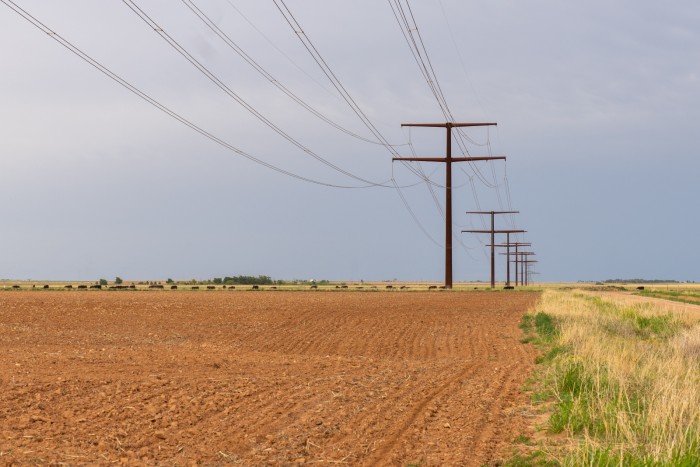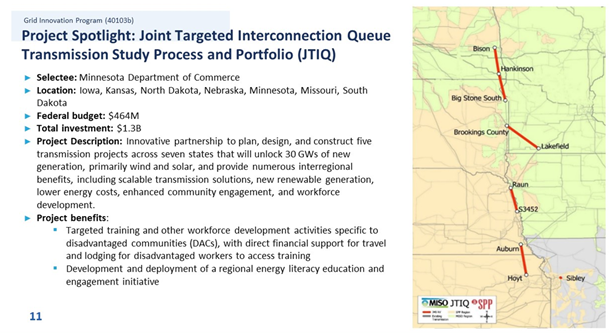Minnesota to Receive $614 MM from DOE as Part of the Largest Investment into America’s Electric Grid
 | Kelley Welf, Communications Director |

 | Kelley Welf, Communications Director |
Funding includes $464 million for Joint Targeted Interconnection Queue Study Transmission Lines
On October 18, 2023, Minnesota Governor Tim Walz announced that the State of Minnesota will receive $614 million from the U.S. Department of Energy (DOE) to improve the power grid's ability to provide cost-effective, sustainable energy to communities throughout the Midwest. This grant includes $464 million from the Inflation Reduction Act for new transmission lines, $50 million for High-Voltage Direct Current (HVDC) substation upgrades in the Minnesota Power territory, and $100 million to support Xcel Energy's efforts in reducing and addressing wildfire threats and enhancing grid resilience during extreme weather conditions. This funding is part of a $3.5 billion investment in 58 projects nationwide to "strengthen electric grid resilience and reliability across America." It is the largest single direct investment ever into America's electric grid.
The work on getting DOE funding to partially defray the cost of the Joint Targeted Interconnection Queue (JTIQ) transmission lines began in earnest over a year ago with a quickly pulled together (but effective) conversation with DOE, Midcontinent Independent System Operator (MISO) and the Southwest Power Pool (SPP) executives, representatives from Clean Grid Alliance (CGA), Advanced Power Alliance (APA), and Grid United. That conversation started the ball rolling toward the objective reached with the DOE announcement in October. The achievement required the support and substantial effort from the State of Minnesota and led to the Department of Commerce ultimately filing an application with DOE. CGA and APA want to thank Minnesota Commissioners Joe Sullivan and John Tuma who helped capture the opportunity for MISO and SPP.
The problem meets a solution
Some folks may not be as familiar with the work CGA and APA have done over the years advocating for the development of a package of transmission lines known as the Joint Targeted Interconnection Queue (JTIQ) transmission lines that are on the "seams" between regional grid operators MISO and SPP. Much like CGA and APA have seen before, the cost of network upgrades identified in the MISO/SPP Affected System Studies is preventing the development of new renewable energy projects. The resulting lack of new transmission is also creating significant congestion on the existing transmission system. This means low-cost wind and solar energy can be wasted when there is not room on the lines for it to be delivered. To deliver the clean energy future that is in such high demand, the JTIQ lines contribute to a long-term solution. Instead of the current interconnection study approach, the DOE's announcement, explains that the JTIQ process will use a coordinated, long-range, interregional assessment that studies multiple projects at once, rather than in sequential or uncoordinated timelines. This will result in scalable transmission solutions, new renewable generation, lower energy costs, and enhanced community engagement and workforce development.
"The projects also bring substantial benefits to consumers on both sides of the SPP/MISO seam contributing to the reliability and resiliency of the regions as well as helping access lower cost clean generation," said APA Senior Vice President Steve Gaw.
“The projects also bring substantial benefits to consumers on both sides of the SPP/MISO seam contributing to the reliability and resiliency of the regions as well as helping access lower cost clean generation.
Steve Gaw, APA Senior Vice President
The result of the projects will be five transmission projects that span across seven Midwest states and will unlock 30 Gigawatts of renewable energy.
 "While there are still a number of issues to be worked out with MISO and SPP (and potentially at FERC, the Federal Energy Regulatory Commission) on how the DOE funds and the costs of the JTIQ projects will be allocated to generators and load, the goal is to make upgrade costs more affordable for renewable energy developers and provide certainty so new wind and solar projects can move forward in the MISO and SPP states," said CGA Executive Director Beth Soholt.
"While there are still a number of issues to be worked out with MISO and SPP (and potentially at FERC, the Federal Energy Regulatory Commission) on how the DOE funds and the costs of the JTIQ projects will be allocated to generators and load, the goal is to make upgrade costs more affordable for renewable energy developers and provide certainty so new wind and solar projects can move forward in the MISO and SPP states," said CGA Executive Director Beth Soholt.
“While there are still a number of issues to be worked out, the goal is to make upgrade costs more affordable for renewable energy developers and provide certainty so new wind and solar projects can move forward in the MISO and SPP states.
Beth Soholt, CGA Executive Director
The JTIQ was among the projects spotlighted during a Grid Deployment Office of the Department of Energy webinar on October 24, 2023. DOE officials stated that this application was one of the most ambitious of all the applications they received and exemplified an "unprecedented level of collaboration."
Next Steps
MISO and SPP will each be filing tariff language with FERC to implement the process and cost allocation for the JTIQ projects. The filings are expected in early 2024. The State of Minnesota will also be setting up a process to administer the DOE funds for the JTIQ projects to the utilities that will build the five transmission lines.